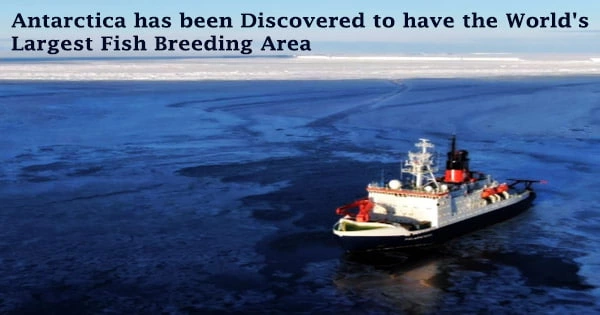A study team has discovered the world’s largest fish breeding habitat known to date near the Filchner Ice Shelf in the south of the Antarctic Weddell Sea. Thousands of icefish nests of the species Neopagetopsis ionah were recorded and filmed on the seafloor using a towed camera system.
Based on the density of the nests and the size of the overall breeding area, an estimated total number of icefish breeding at the time of observation was around 60 million. These findings suggest the construction of a Marine Protected Area in the Southern Ocean’s Atlantic region.
In the current issue of the scientific journal Current Biology, a team lead by Autun Purser from the Alfred Wegener Institute publishes their findings.
Researchers were overjoyed when they saw several fish nests on monitors aboard the German research vessel Polarstern in February 2021, thanks to their towed camera system, which relayed live from the seabed, 535 to 420 meters below the ship, in the Antarctic Weddell Sea.
The excitement intensified as the operation progressed, eventually leading to disbelief: nest after nest, with the subsequent detailed study revealing that there was one breeding site every three square meters on average, with the team finding a maximum of one to two active nests per square meter.
The area has a total area of 240 square kilometers, which is nearly the size of the island of Malta, according to the mapping. The total number of fish nests was estimated to be over 60 million when extrapolated to this geographical size.
“The idea that such a huge breeding area of icefish in the Weddell Sea was previously undiscovered is totally fascinating,” says Autun Purser, a deep-sea biologist at the Alfred Wegener Institute, Helmholtz Centre for Polar and Marine Research (AWI) and lead author of the current publication.
Since the early 1980s, the Alfred Wegener Institute has been researching the area with its icebreaker Polarstern. Only one Neopagetopsis ionah or tiny clusters of nests have been discovered so far.
My congratulations to the researchers involved on their fascinating discovery. After the MOSAiC expedition, German marine and polar research has once more reaffirmed its outstanding position. German research vessels are floating environmental research laboratories. They continue to sail the polar seas and our oceans almost non-stop, serving as platforms for science aimed at generating important findings to support climate and environmental protection.
Bettina Stark-Watzinger
The Ocean Floor Observation and Bathymetry System, or OFOBS, is used to make unique observations. It’s a camera sledge designed to explore the seafloor in harsh conditions, such as ice-covered oceans. It is generally pulled at a pace of half to one knot, about one and a half meters above the seafloor, on a specific fiber-optic and power line.
“After the spectacular discovery of the many fish nests, we thought about a strategy on board to find out how large the breeding area was there was literally no end in sight. The nests are three-quarters of a meter in diameter so they are much larger than the structures and creatures, some of which are only centimeters in size, that we normally detect with the OFOBS system,” Autun Purser reports.
“So, we were able to increase the height above ground to about three meters and the towing speed to a maximum of three knots, thus multiplying the area investigated. We covered an area of 45,600 square meters and counted an incredible 16,160 fish nests on the photo and video footage,” says the AWI expert.
The crew was able to clearly identify the circular fish nests, which were around 15 centimeters deep and 75 centimeters in diameter and distinguished from the generally murky bottom by around core patch of small stones, based on the photos.
Several types of fish nests were distinguished: Nests that were “active,” carrying between 1,500 and 2,500 eggs and guarded in three-quarters of the cases by an adult Neopagetopsis ionah icefish, or nests that had only eggs; there were also unused nests, in the vicinity of which only a fish without eggs or a dead fish could be spotted.
The researchers used OFOBS’s longer-range but lower-resolution side scan sonars, which recorded over 100,000 nests, to map the distribution and density of the nests. The researchers combined their findings with data from the ocean and biology.
As a result, the breeding area is spatially aligned with the inflow of warmer deep water from the Weddell Sea onto the upper shelf. The multidisciplinary team was also able to show that the region is a favored destination for Weddell seals using transmitter-equipped seals.
90% of the seals’ diving actions were in the vicinity of active fish nests, where they are presumably looking for food. It’s no surprise that the ice fish colony there has a biomass of 60 thousand tonnes, according to the experts.
According to the scientists, this massive breeding area is an incredibly significant ecosystem for the Weddell Sea because of its biomass, and it is likely to be the largest geographically extensive contiguous fish breeding colony identified worldwide to date, according to the current study.
German Federal Research Minister Bettina Stark-Watzinger said: “My congratulations to the researchers involved on their fascinating discovery. After the MOSAiC expedition, German marine and polar research has once more reaffirmed its outstanding position. German research vessels are floating environmental research laboratories. They continue to sail the polar seas and our oceans almost non-stop, serving as platforms for science aimed at generating important findings to support climate and environmental protection.”
German marine and polar research now has one of the most modern research vessel fleets in the world, thanks to funding from the Federal Ministry of Education and Research (BMBF).
This discovery has the potential to significantly aid in the preservation of the Antarctic environment. Under the auspices of the United Nations Decade of Ocean Science for Sustainable Development, which runs until 2030, the BMBF will continue to work toward this goal.
The present study, according to AWI Director and deep-sea biologist Prof. Antje Boetius, demonstrates how critical it is to develop marine protected areas in Antarctica.
“This great discovery was enabled by a specific under-ice survey technology we developed during my ERC Grant. It shows how important it is to be able to investigate unknown ecosystems before we disturb them. Considering how little known the Antarctic Weddell Sea is, this underlines all the more the need of international efforts to establish a Marine Protected Area (MPA),” Antje Boetius classifies the results of the study, in which she was not directly involved.
The Alfred Wegener Institute led the development of a plan for such an MPA, which has been advocated by the European Union and its member states, as well as other supportive countries, in the International Commission for the Conservation of Antarctic Marine Living Resources (CCAMLR) since 2016.
Antje Boetius adds: “Unfortunately, the Weddell Sea MPA has still not yet been adopted unanimously by CCAMLR. But now that the location of this extraordinary breeding colony is known, Germany and other CCAMLR members should ensure that no fishing and only non-invasive research takes place there in the future. So far, the remoteness and difficult sea ice conditions of this southernmost area of the Weddell Sea have protected the area, but with the increasing pressures on the ocean and polar regions, we should be much more ambitious with marine conservation.”
















